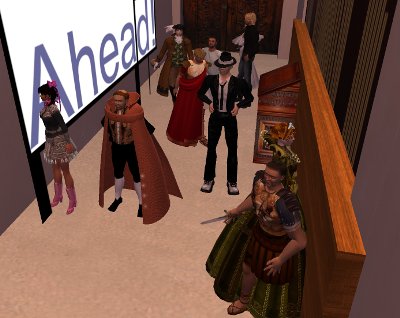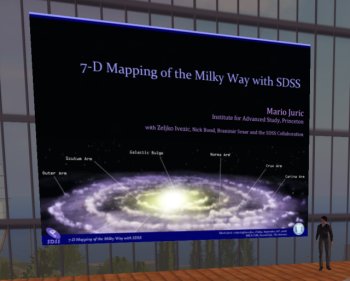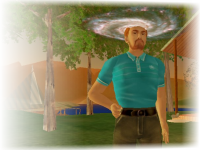Actors Backstage
Posted on May 29th, 2009 — permalink

This is a snapshot I took during a rehearsal for Avatar Repertory Theater’s upcoming performance “Shakespeare at the Pavillion” (Saturday and Sunday, 4PM PDT in the San Diego City sim in Second Life). A bunch of us were backstage, costumed up for various upcoming scenes. It looks very much like a classic “backstage” such as you might find in a real-life theater; lots of people, standing around, dressed up in all manner of wacky costumes.
Comments Off
Posted in Second Life, Second Life Events, Uncategorized |
Shakepseare & Relativity in-world this weekend
Posted on May 28th, 2009 — permalink
I’m going to be busy this weekend with a public outreach talk and some Shakespeare performances.
Saturday morning at 10AM SLT/PDT, I’ll be giving a talk entitled Time dilation and simultaneity in Special Relativity. This is part of the regular “Dr. Knop Talks Astronomy” public-outreach talk series given by MICA. If you’re curious about just why it is that moving clocks run slow in special relativity, drop by and I’ll explain it. You don’t need any math to understand the basics; with just early high-school algebra (the Pythagorean Theorem), you can even understand the equation for how slow clocks run. The talk will be at the MICA Large Amphitheater (StellaNova (213, 210, 32)).
Then, Saturday and Sunday from 4PM-5PM, Avatar Repertory Theater will be performing scenes from several Shakespeare plays in our “Shakespeare at the Pavilion” performance, in association with the San Diego City sim. We’ll do scenes from Twelfth Night, Julius Caesar, Hamlet, As You Like It, and A Midsummer Night’s Dream. See the A.R.T. site for more information.
I remind everybody that a Second Life account is free. Here is one place you can register for an account— that’s the registration portal for the SciLands, a contiguous group of regions of which MICA is a member. That will take you to the SciLands’ orientation spot. Both of the events above will use Second Life Voice, but you don’t need a microphone or a headset; you’ll just need your standard computer speakers to hear what’s going on. There are Second Life viewer applications for Linux, MacOs, and Windows.
Comments Off
Tags: shakespeare relativity mica stellanova second life 2ndl
Posted in Physics & Astronomy, Science, Second Life, Second Life Events |
When Stars Collide
Posted on May 26th, 2009 — permalink
When I’ve given talks about colliding galaxies, I always start out by pointing that that the stars within a galaxy basically never collide with each other. This is, of course, an oversimplification….
You may have seen a “scale model” of the Solar System. It gives you a sense of how amazingly spread out things are… especially after you’ve made the hike to get to Saturn, never mind Uranus, Neptune, or the Kuiper Belt. But you never see a scale model of the nearby stars. Why? because things are even more amazingly spread out. Suppose I wanted to make such a scale model, and, here in Nashville, TN, I used a tennis ball to represent the Sun. To represent the nearest star, α Centauri, I’d need another tennis ball that is in New York City. Stars are really, really far apart from each other. Our galaxy is mostly empty space. (Well, actually it’s mostly dark matter, but within the disk of the galaxy, the mass density is more stars than dark matter. And, between the stars, there is interstellar gas, but the density of that gas is much lower than the density of gas in the best vacuum chamber we’ve built on Earth.)
However, there are places where this isn’t strictly true. We see some stars in globular clusters that are more massive than stars that have any business still being around in that globular cluster. (That is, globular cluster stars were all formed 11-13 billion years ago. Stars with higher mass have shorter lifetimes, so any star above a certain mass cutoff isn’t seen in a globular cluster.) One very likely explanation for this is that these stars are the result of a merger between two lower-mass stars.
It may also be possible in some very rich young clusters of stars that stars may collide with each other before the cluster disperses. The black hole at the center of our galaxy may very rarely “eat” a star. (No, we haven’t seen this happen.)
Last week, Jamie Lombardi of Allegheny college gave a seminar in Second Life as part of the MICA professional seminar series entitled “The Hydrodynamics of Runaway Collisions.” At the very beginning of the talk, he had to clarify that he was in fact talking about colliding stars. I give a lot of public-outreach astronomy talks for MICA (a different series, obviously, from the serious of professional seminars), and I have given a couple of talks about colliding galaxies. My own history as an astronomer leads me to think “collisions” to mean “between galaxies”– and the hydrodynamics, then, must be referring to the gas processes that might, say, feed an AGN.
However, cool things can happen when three stars have a close enough pass that their envelopes start to spill on to each other. Sometimes, two of the stars will merge (while the third one in the collision is ejected). Some of the gas is lost, but much of it stays behind in a more massive star. The timescale for these collisions is short enough that the stars will not evolve appreciably during the collision, so this may well be a way that you can make a star that’s more massive than what would naturally form out of star formation nowadays— especially if you can chain together several collisions. What Jamie was talking about, of course, probably only applies in very young, very rich clusters. The globular clusters in our Galaxy today are too old to have the kind of massive stars that Jamie was focusing on in his talk, and most of the star forming clusters nowadays have several orders of magnitude fewer stars than globular clusters do. But, globular clusters were once young….
Comments Off
Posted in Physics & Astronomy, Science, Second Life Events |
To be clear : Linden is full of really stellar people doing really good things.
Posted on May 26th, 2009 — permalink
I do not want my previous post to be interpreted as me disparaging Linden as a whole. I am not happy with what I see written in the termination agreement right now, but perhaps my unhappiness comes from the fact that I don’t speak Lawyer. Hopefully I’ll find out.
To be clear, though, Linden has a collection of really strong people. I think that people in support and engineering alike get a really bad rap from a lot of residents, blog posts and comments, and sometimes in the media. Things like this 1000-prim limit on coalesced objects in server 1.26 (that may or may not change in the near future); that’s not the Lindens being capricious and uncaring about residents, it’s them trying to deal with real and thorny problems in the second life server. There are really good, really smart people at Linden trying to make Second Life the best it can be. It’s a hard problem. I don’t agree with everything Linden does or is doing (obviously, because I was fired), but there are great people there. I had a great working relationship with the vast majority of the people I worked with, and have nothing but great respsect for them.
6 Comments
Posted in Linden Lab, Rant, Second Life |
This Saturday at 10AM PDT in SL : “How We Know Dark Matter Exists”
Posted on April 29th, 2009 — permalink
As part of my regular Dr. Knop Talks Astronomy series of public astronomy lectures in Second Life, this coming Saturday I’ll be talking about how we know that Dark Matter really exists.
The talk will be at the Large Ampitheater on StellaNova. Note that a Second Life account is completely free! You can register for an account here. This is the “SciLands” entry portal, which will put you at the SciLands own orientation island. (StellaNova, the sim of MICA, is part of the SciLands.)
Here’s a description of the talk:
Modern cosmology tells us that the majority of the Universe is made up of stuff whose nature is largely unknown to us. Two thirds of it is Dark Energy; most of the rest is Dark Matter, the subject of this talk. Dark Matter interacts with normal matter through gravity, but otherwise it interacts hardly at all. Yet, we have very high confidence that this mysterious Dark Matter really does exist. Because it doesn’t interact with light, we haven’t seen it glowing, nor have we observed it absorbing background light as we’ve seen with dust clouds. All of the evidence we have for Dark Matter comes from its gravitational interaction with other matter, and with light. Yet, this evidence is extremely compelling. In this talk, I will attempt to convince you that there is no reasonable doubt that Dark Matter exists.
Comments Off
Posted in Cosmology, Physics & Astronomy, Science, Second Life, Second Life Events |
This Saturday : “The Discovery of the Accelerating Universe” in Second Life
Posted on April 1st, 2009 — permalink
“Dr. Knop Talks Astronomy”, in association with MICA (www.mica-vw.org)
Saturday, April 4, 10AM SLT
http://slurl.com/secondlife/StellaNova/213/210/32
The Discovery of the Accelerating Universe
In 1998, two teams of astronomers observing supernovae discovered that the expansion of the Universe is accelerating. The speaker, Dr. Knop, was on one of the two teams, working with Saul Perlmutter. In this talk, I will describe just how it is that you can measure the expansion history of the Universe by observing distant exploding stars, and what surprising things we saw in our results that indicated to us that the expansion of the Universe was in fact accelerating. At the end, I’ll briefly mention some things about “dark energy,” the mysterious substance that is causing this surprising universal acceleration.
Comments Off
Posted in Cosmology, Physics & Astronomy, Science, Second Life |
“Science at Play” — a play writing workshop in Second Life
Posted on January 19th, 2009 — permalink
Starting today at 2PM PST, I and others will be leading playwriting workshops at the Kira Cafe. The genesis of this idea came from Piet Hutt, one of the directors of the Kira Institute, after I gave an informal talk about what it was like to perform live theater in Second Life. As the mission of Kira is to talk about science in context, he thought it would be neat if we were to try putting on some plays related to science. One recent example is the play “Copenhagen” by Michael Frayn, although myself I am more familiar with “Hapgood” and “Arcadia” by Tom Stoppard.
The discussion evolved, and we decided that perhaps it would be interesting to think about getting people together to talk about writing plays, perhaps very short plays, that explore things related to science— and that are written from the beginning understanding both the advantages and the limitations that come from performing theater in Second Life (as opposed to live on stage).
If this sounds interesting to you, feel free to drop by the Kira Cafe today, and over the next few weeks on Mondays at 2PM SLT, to join us. The Kira Cafe can be found in Second Life at BaikUn (198, 76, 99).
1 Comment
Posted in Science, Second Life, science & society |
Popular Astronomy Talk in Second Life, Friday 8AM PDT (11AM EDT)
Posted on October 9th, 2008 — permalink
I’ll be giving a talk entitled: “We Are Starstuff: the Cosmic Origins of the Chemical Elements” as a part of the MICA public talks series. The talk will be at the Galaxy Dome in Spaceport Bravo.
Remember, a Second Life account is free!
Comments Off
Posted in Physics & Astronomy, Science, Second Life, Second Life Events |
Astrophysics in Second Life : 7D mapping of the Galaxy with SDSS
Posted on September 27th, 2008 — permalink
Yesterday (Friday Sep. 26), MICA heard its first Journal Club of the academic year. (We’ve had these before, but it was very slow over the summer.) The talk was Mario Juric from IAS Princeton, talking about mapping density, velocity, and metallicity as a function of spatial position within the Milky Way galaxy, using photometric data from the Sloan Digital Sky Survey.

click for a larger image
There were a few conclusions that came out of this. First, unsurprising to anybody who’s read anything about the structure of the Milky Way, the disk and the halo really are completely separate components. The disk appears to have a vertical (i.e. perpendictular to the plan) gradient of metallicity, whereas the halo has a constant (and lower) metallicity distribution. Some density outliers from the smooth background are there, which were known previously, including the Monocerous Tidal Stream discovered by my friend and one-time collaborator Heidi Newberg
However, there were also some surprises. There’s basically no gradient of metallicity radially along the disk. I had previously been under the impression that the disk had a metallicity gradient, with higher metallicities towards the center. One caveat to this: the data does not include the very center of the plane of the disk, so there may well still be a metallicity gradient within the plane.
(more…)
2 Comments
Posted in Physics & Astronomy, Science, Second Life |
Virtual Starry Night : can a derivative work be original and creative?
Posted on September 25th, 2008 — permalink
Oh, yes. Oh, yes it can.
Watch this:
YouTube — Watch the World
Gave me chills. An amazing piece of work, all the more so because it’s based on a classic piece of artwork which isn’t the sort of thing that you would think would translate well into a 3d environment with crisp rendering.
1 Comment
Posted in Second Life |


